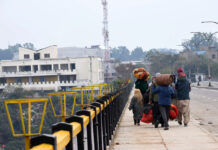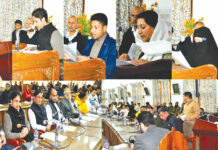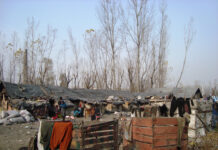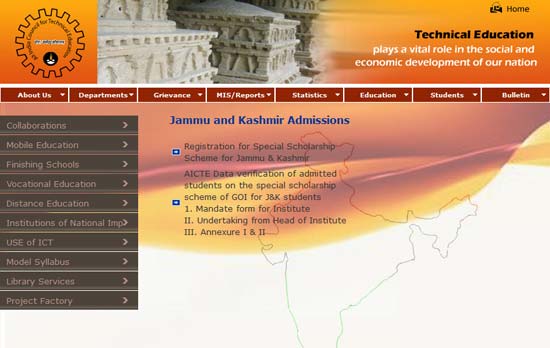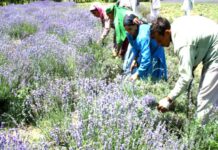Even after announcing to convert Naseem Bagh into a heritage park, the university authorities have constructed buildings in the area and cut down 22 Chinars. Ikhlaq Qadri reports.
The Kashmir university authorities are cutting down and pruning Chinar trees in the Naseem Bagh Campus saying that it is being done to build a heritage park there. The university has also demolished some barrack type huts and relocated the families of non-teaching staff putting up in those huts, while at the same time two huge brick and mortar buildings – Distance Education department and the guest house – were constructed in the campus.
 The Naseem Bagh Campus in the University of Kashmir spreads over 451 hundred kanals of land and houses hundreds of Chinars. The decision to convert the campus into a heritage park was made in January 2010. The university authorities claim that the move was made to save the heritage by preserving the Chinars.
The Naseem Bagh Campus in the University of Kashmir spreads over 451 hundred kanals of land and houses hundreds of Chinars. The decision to convert the campus into a heritage park was made in January 2010. The university authorities claim that the move was made to save the heritage by preserving the Chinars.
The university has cut 22 Chinars which they claim were dead and rest treated by pruning, filling root and painting.
“We had 718 chinars among which 22 were dead. Now we are having 696 which are being treated scientifically,” said Prof. B A Wafai head of the department of Landscape division, Kashmir University.
As the authorities started pruning Chinars, it evoked criticism from student fraternity and the civil society. The university authorities convinced the activists after deliberations with them and continued the process.
“When they were ruthlessly cutting Chinars, we objected. The officials of university had meeting with us and they told us this all is being done to save heritage. After agreeing we decided to monitor the proceedings,” said poet, environment activist and chairman Valley Citizens’ Council Zareef Ahmad Zareef.
However Zareef distanced himself from the recent Chinar pruning drives in the campus.
“Are they again doing it, I don’t know,” he said.
Interestingly, the design of proposed heritage park is yet to complete.
“The heritage project being designed by a Delhi-based company with people from Kashmir is in the final stages. After its completion the design will be discussed with the vice chancellor for its approval,” said Prof. Wafai.
However, Prof. Wafai says that the university is taking up the project in a phased manner and as a first step the “diseased Chinars are being treated”.
“After proper permission from state authorities we started to treat diseased Chinars. This won’t be done in one go but will be taken in a phased manner,” he said.
Sources in the varsity told Kashmir Life that the heritage project that was launched with much pomp and show has been reduced to mere stripping of Chinars and demolition of small huts.
“The announcement to convert the Naseem Bagh (campus) into a heritage park was made on January 13, 2010. But so far what we witnessed is only the denuding of Chinars and demolition of huts.” the sources in the university said.
The heritage project, sources said, was likely to face shortage of funds as the university is short of funds and has already cut down the salaries of its contractual employees by almost 40 per cent.
“The University does not have funds to pursue the project. The authorities are planning to seek assistance from Non-Governmental Organizations, state government, central government and private enterprises for funding the project,” they said.
The officials stated that University will provide funds and also some non-governmental organisations and private enterprises will be approached.
“We won’t burden the university entirely. We will seek funds from private organisations, state government and central government as well,” said Prof Wafai,.
Prof Wafai said that 225 Chinars have been treated last year and the rest are being treated this year. The officials said that the process will be complete by the end of this February.
“The pruning time is only up to March 15 because after that the foliage comes out,” said Prof. Wafai.
As part of the heritage park project the university also removed barrack type huts housing families of some non-teaching staff in the Naseem Bagh campus.
“We relocated 29 families and the process will be completed this year,” officials said.
The civil society, however, is not in favour of making major changes to the campus.
“Let university include the people of all shades to finalise any plan,” said Zareef.
But the university authorities say taking everybody on board is not possible. “This will lead to chaos… We will include limited group who have expertise in the field,” the official said.
Naseem Bagh was constructed on the banks of Dal Lake by the Mughal Emperor Akbar in 1586 AD. The area was known for around 992 Chinars, which were so dense that these even prevented sunlight from reaching to the ground.
The government engineering college was started from the picturesque Naseem Bagh campus before the construction of the Regional Engineering College in nearby Nigeen locality. Subsequently the huts in the area were used as classrooms and residential quarters for the teaching and non-teaching staff.
 “Naseem Bagh has been considered the best place in the entire campus. The shade and soothing breeze in summer was what we missed this year.” said a student of Business School without wishing to be named.
“Naseem Bagh has been considered the best place in the entire campus. The shade and soothing breeze in summer was what we missed this year.” said a student of Business School without wishing to be named.
Meanwhile, the University has completed construction of multi-storey guest house within Naseem Bagh. The construction of the building was started in 2007.
“The guest house was constructed at the cost of cutting roots of almost 20 Chinars,” said Zareef. “They had personal interest in constructing the guest house”.
The officials say that the university badly needed a guest house.
“We had no option but to build the guest house as the one we had was under the occupation of security forces. The university is expanding and so the need to accommodate guests,” said Prof. Wafai.
He also said that now onwards there is a blanket ban on any type of construction in the Naseem Bagh.
“Whatever is done in past was the necessity. Now onwards there won’t be any construction,” Prof Wafai said.
The alumni of university term the “ban” as a face saver alleging that the authorities continue to destroy the heritage.
“They have said the same thing (of imposing a ban on constructions) so many times but have been doing it (constructing buildings) again and again,” said Sajad Ahmad, a former student.
“They did it in tenure of Prof Jalees Khan, Prof Abdul Wahid and now doing again. Every time they say is the last time,” he said.
The students who have spent their time of university in the Naseem Bagh cut sorry figure for its changed state.
“It was heavenly feeling to take classes in huts and enjoy nature. To have a coffee while walking through the lanes having full blossomed Chinar on both sides,” said Danish, a Mass communication graduate.
The students who were part of protests when Distance Education department was to be constructed in the Naseem Bagh termed their helplessness as unfortunate for coming generations.
“We protested but failed miserably to stop officials from carrying out the construction. It is unfortunate for generations to come.” said journalist, Sarwar Kashani, who was a student at the university in 2002, when the university constructed the Distance Education department building in Naseem Bagh.


